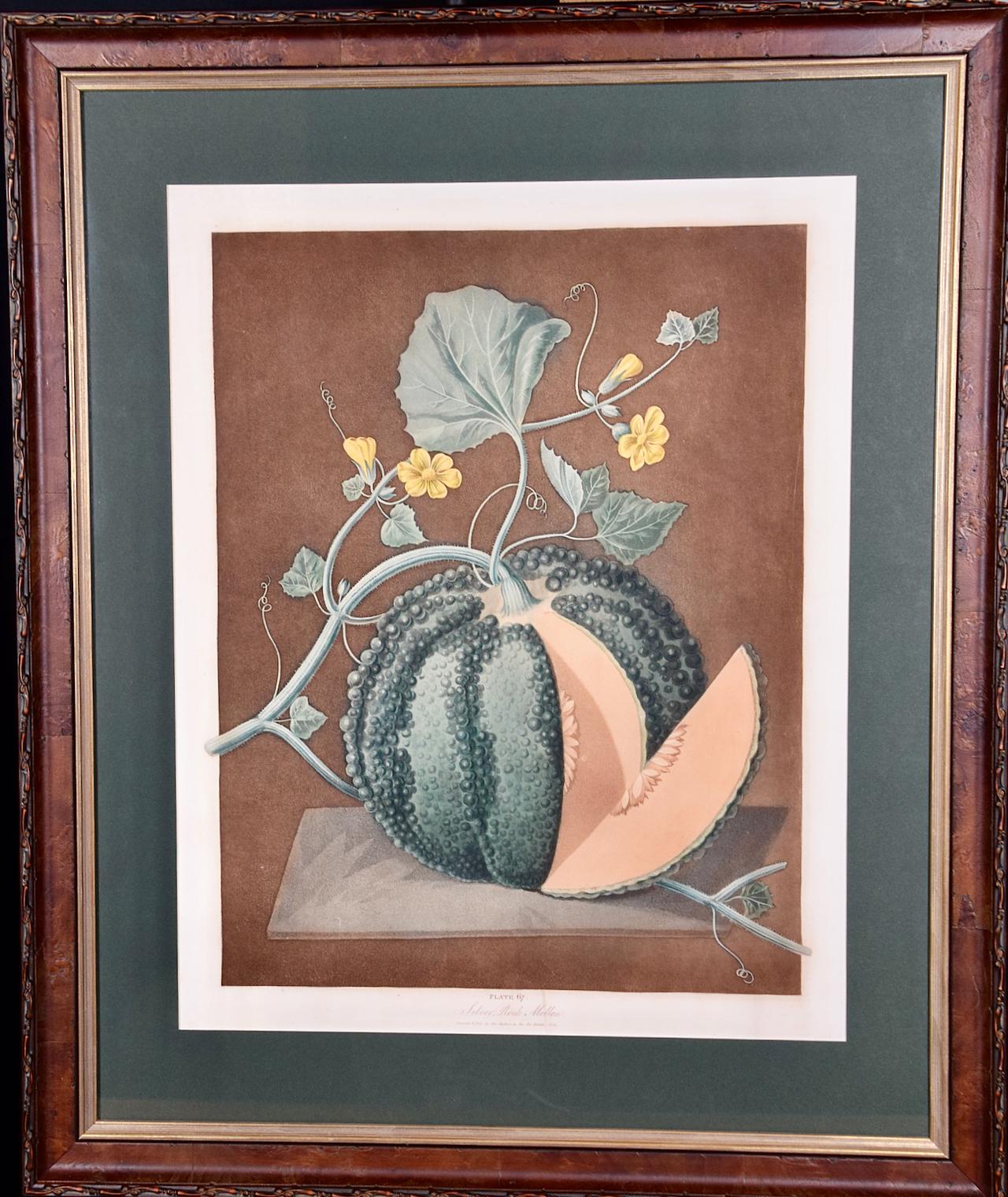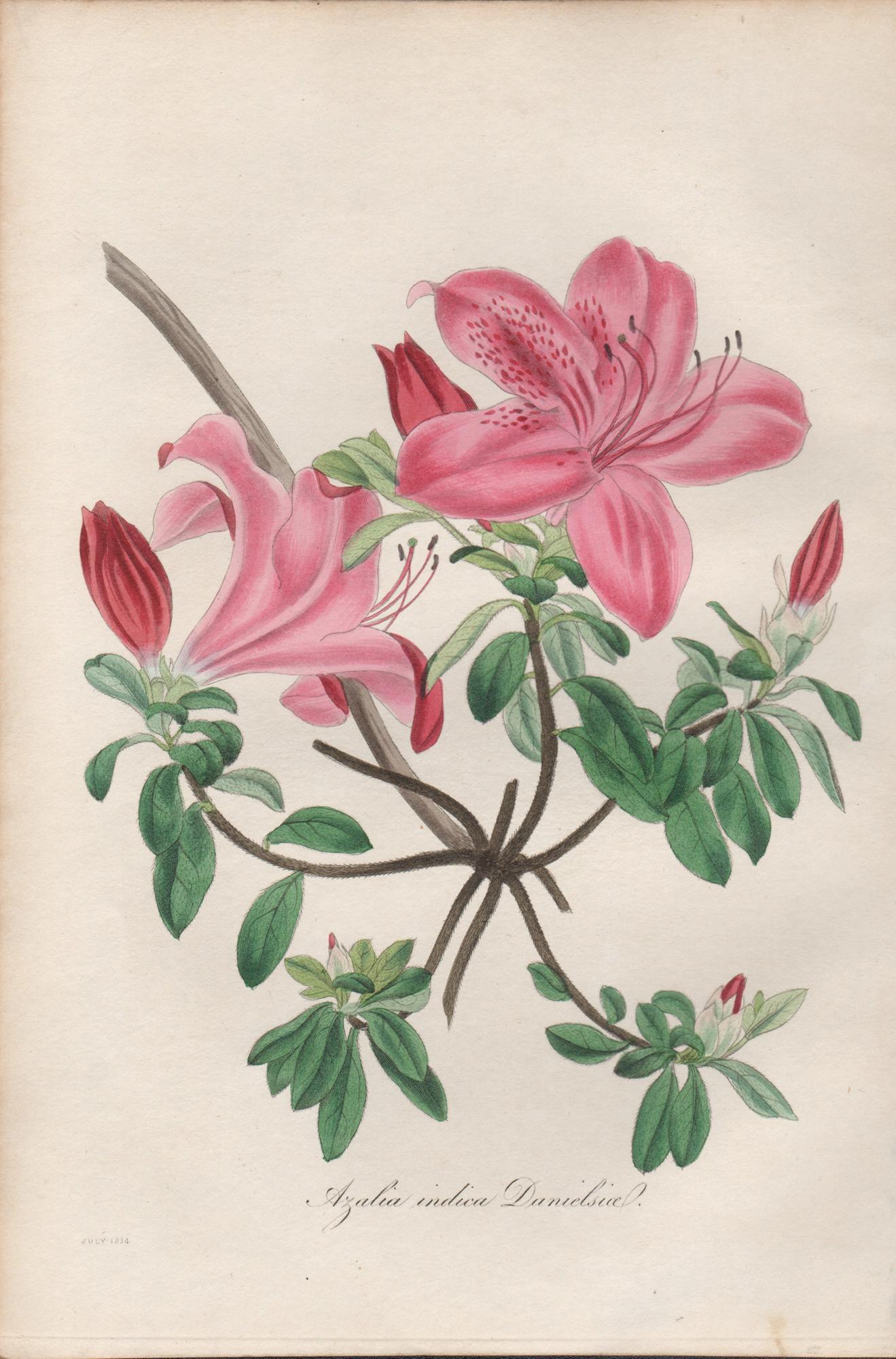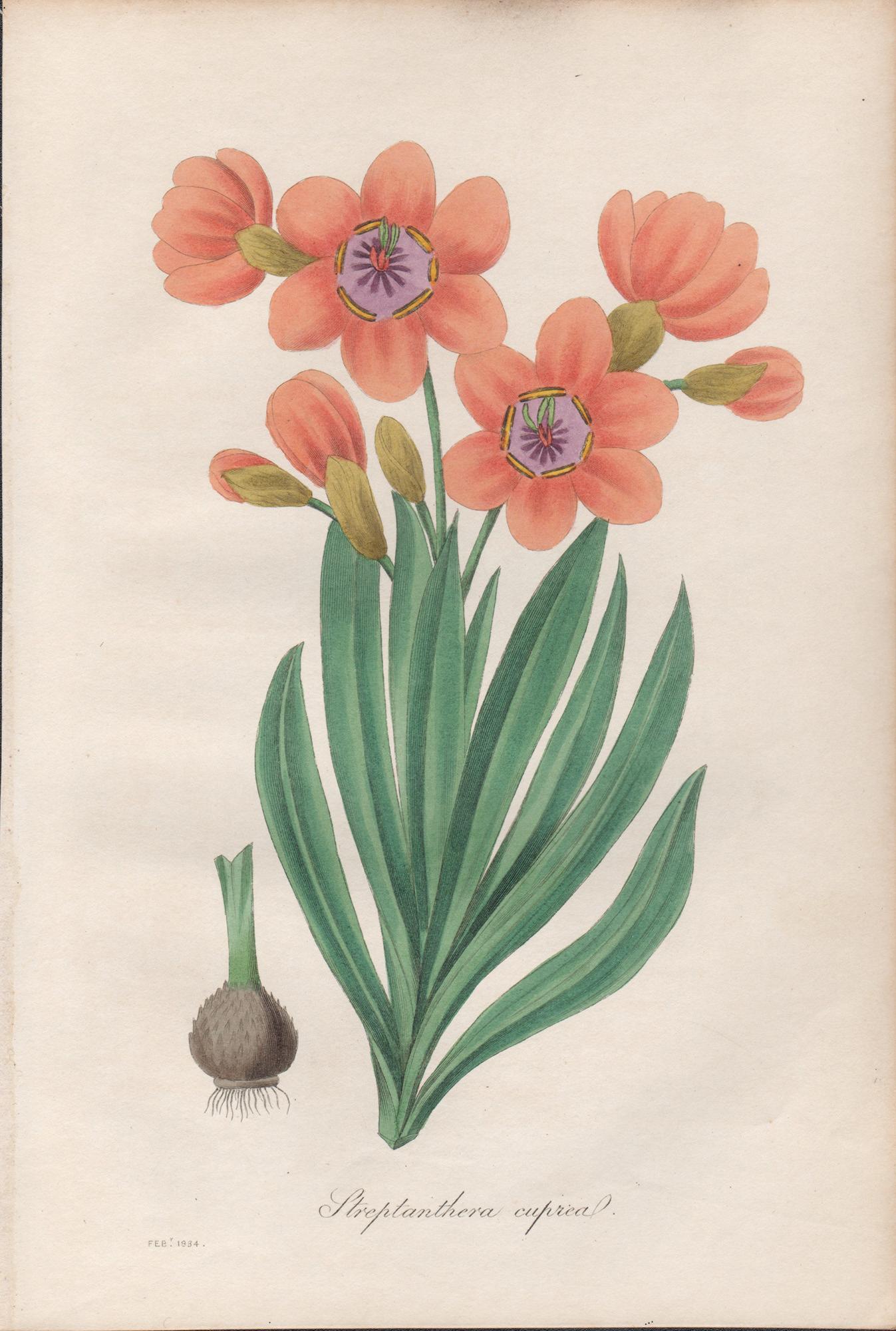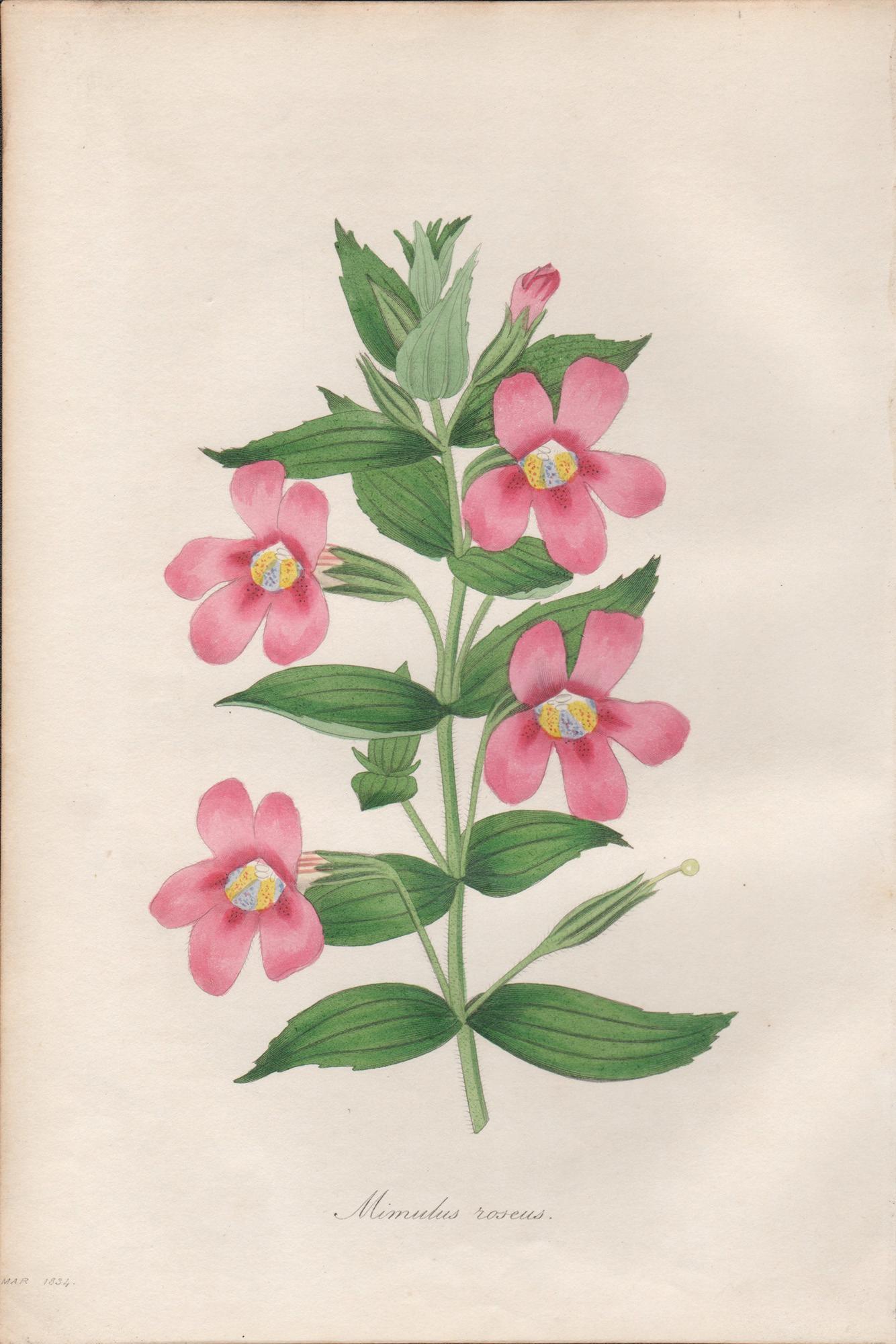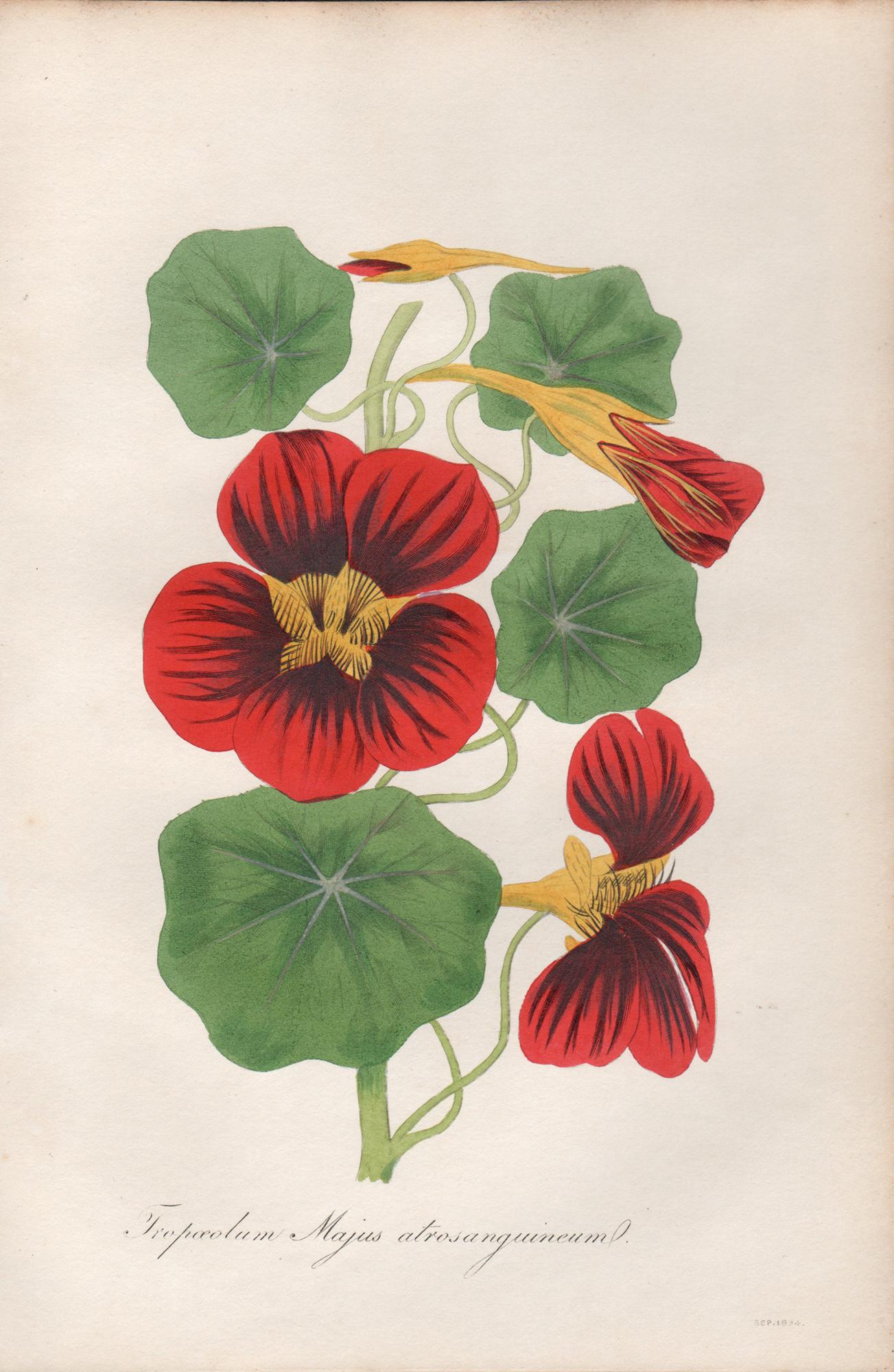Items Similar to "Amicua Melon" Hand Finished Color Engraving by George Brookshaw
Want more images or videos?
Request additional images or videos from the seller
1 of 11
George Brookshaw"Amicua Melon" Hand Finished Color Engraving by George Brookshaw1812
1812
About the Item
This is a colored aquatint and stipple engraving finished by hand entitled "Amicua Melon", drawn and engraved by George Brookshaw and published in London in 1812 as plate LXXII in his 'Pomona Britannica; or, A Collection of the Most Esteemed Fruits'. It depicts a melon still on the vine, but with a wedge cut out to reveal the internal anatomy of the fruit. The vine, leaves and beautiful flowers are shown in attractive and pleasing colors, which along with the melon sit on a light gray board. The vine is a light green grey color, the melon skin and leaves are colored in different shades of green, the melon flesh in a peach-color and the flowers are yellow. The scene is reminiscent of an engraving in an 18th century artistically stylized human anatomy atlas.
The engraving is presented in an archival museum style antiqued gold-colored and dark brown wood frame with a beige outer mat with a gold highlight and a brown inner mat. The frame measures 29.57" high, 25.57" wide and 1.25" deep. There are a few small defects along the edge of the frame, but it is otherwise in very good condition. Multiple tiny faint spots are present on the beige mat. A few small spots are present in the margin of the print, which is otherwise in very good condition.
Brookshaw spent nearly ten years to create 'Pomona Brittanica'. It is considered a masterpiece among 19th-century British illustrated botanical books due to the illustrations that Brookshaw both drew and engraved for the book. He combined aquatint, stipple and line engraving techniques with unique elegant compositions of his subjects portrayed in rich pleasing colors contrasted by striking and dramatic deep chocolate brown backgrounds that make the fruit appear to float off of the paper. His compositions achieved a unique level of artistic style and beauty combined with academic and scientific content that was rare among the work of other artists of the time.
George Brookshaw (1751–1823) began his career as a cabinet-maker specializing in furniture decorated with borders of flowers. He became a professional art teacher and in 1797 he published an instructional guide entitled "A New Treatise on Flower Painting". He eventually became a professional artist and author, publishing 'Pomona Brittanica' in 1812, late in his career. His goal was to create a visual display of some of the best examples of fruit available in England at the time, which he hoped would encourage gardeners to experiment and to be creative in their gardens. 90 striking drawings and engravings of over 250 varieties of fruit are illustrated, including apples, peaches, melons, grapes and pears. Some of the subjects for his illustrations were found in the royal gardens at Hampton Court, Kensington Gardens and the Prince of Wales' estate in Blackheath.
- Creator:George Brookshaw (1751 - 1823, British)
- Creation Year:1812
- Dimensions:Height: 29.57 in (75.11 cm)Width: 25.57 in (64.95 cm)Depth: 1.25 in (3.18 cm)
- Medium:
- Movement & Style:
- Period:
- Condition:
- Gallery Location:Alamo, CA
- Reference Number:
About the Seller
5.0
Platinum Seller
These expertly vetted sellers are 1stDibs' most experienced sellers and are rated highest by our customers.
Established in 2011
1stDibs seller since 2019
233 sales on 1stDibs
Typical response time: 1 hour
- ShippingRetrieving quote...Ships From: Alamo, CA
- Return PolicyA return for this item may be initiated within 7 days of delivery.
More From This SellerView All
- White Hamburgh Grape: A Framed 19th C. Color Engraving by George BrookshawBy George BrookshawLocated in Alamo, CAThis is a 19th century colored aquatint and stipple engraving finished by hand entitled "White Hamburgh Grape", drawn and engraved by George Brookshaw and published in London in 1812 as plate 60 in his 'Pomona Britannica; or, A Collection of the Most Esteemed Fruits'. It depicts a cluster of pale green grapes still on the vine. The vine and leaves are shown in attractive shades of green and brown. The plant lays on a brown textured background with shadows to impart 3-dimensionality. The scene is reminiscent of an engraving in an 18th century artistically stylized human anatomy atlas. There is a light brown title rectangle in the lower center which is blank, suggesting this may be a more rare preproduction proof. There are wide white margins. This striking engraving is presented in a reddish brown decorative wood frame with a darker brown scroll-work outer trim and a gold-colored inner fillet and a thick light beige mat. The frame measures 26" high, 22" wide and 1.13" deep. It is glazed with UV conservation glass. There is a tiny spot in the lower margin on the left and another in the left margin. The print and frame are otherwise in excellent condition. There is a second Brookshaw engraving that is framed in identical moulding, although a slightly different size and a different color mat. It depicts a Silver Rock Melon. The two prints would make a striking display pairing...Category
Early 19th Century Naturalistic Still-life Prints
MaterialsEngraving, Aquatint
- Silver Rock Melon: A Framed 19th C. Color Engraving by George BrookshawBy George BrookshawLocated in Alamo, CAThis is a 19th century colored aquatint and stipple engraving finished by hand entitled "Silver Rock Melon", drawn and engraved by George Brookshaw and published in London in 1812 as plate 67 in his 'Pomona Britannica; or, A Collection of the Most Esteemed Fruits'. It depicts a Silver Rock Melon still on the vine, but the melon lies on a heater green mat. A wedge of the melon has been dissected to reveal its inner anatomy, including the seeds. The melon skin is a heather and light green color, while the inner portions are a light peach color. The vine and leaves are shown attractive shades of light green and there are soft yellow flowers. The plant is displayed on a light brown textured background with shadows to impart 3-dimensionality. The scene is reminiscent of an engraving in an 18th century artistically stylized human anatomy atlas. There are wide white margins. The title and inscription lies within the lower border. This striking engraving is presented in a reddish brown decorative wood frame with a darker brown scroll-work outer trim and a gold-colored inner fillet and a thick heather green mat. The frame measures 25.75" high, 21.5" wide and 1.13" deep. It is glazed with UV conservation glass. There is a short thin vertical line of discoloration in the lower margin through the word "melon" and a tiny spot in the upper margin on the left. The print and frame are otherwise in excellent condition. There is a second Brookshaw engraving that is framed in identical moulding, although a slightly different size and a different color mat. t depicts a cluster of grapes. The two prints would make a striking display pairing...Category
Early 19th Century Naturalistic Still-life Prints
MaterialsEngraving, Aquatint
- Redoute Hand-colored Engraving of Cactus Flowers "Cactus Peruvianus Cierge"By Pierre-Joseph RedoutéLocated in Alamo, CAThis framed hand-colored stipple engraving entitled "Cactus Peruvianus Cierge du Pérou" by Pierre-Joseph Redouté, Plate 58 from his illustrated publication 'Plantarum Historia Succulentarum ou Histoire des Plantes Grasses', published in Paris in 1799. It depicts a branching limb of a cactus with a beautiful flower. There is a separate detail of the anatomy of a seed with early growth. Redoute was a pioneer of the stipple engraving technique, which he used to create this image. It involves utilizing a series of small dots worked into a copper plate rather than the more common lines. These dots can be made smaller or thicker depending on the degree of opacity the artist intends for various areas of the print. When inked and applied to paper, this allows for a greater portion of the paper to be seen, which accentuates the appearance of luminosity of the subject the artist is creating. Different color inks are used in the printing process, a time consuming technique known as "a la poupee". The engraving is then finished with watercolor to further enhance the beauty and realism of the print subject. This engraving of a flowering cactus is presented in silver-colored ribbed wood frame and a double mat; cream-colored outer mat and heather green inner mat. The frame measures 21.25" high by 17.25" wide by 1.13" deep. The sheet measures 19.88" high by 14" wide. There are wide margins with a few short tears and chips along the the left, right and upper edges, which are all covered by the mat. There are small spots predominantly in the margins, with a few present in the image area. The print is otherwise in very good condition. There is another Redoute flowering cactus listed on 1stdibs, LU117326853392, which is framed and matted identically to this one. The pair would make an attractive display grouping. Pierre-Joseph Redouté (1759-1840), was a painter and botanist originally from Belgium, who pursued his extremely successful artistic career in France. He is well known for his watercolor paintings of roses, lilies and other flowers and their subsequent folio-sized, color stipple engravings. Some believe him to be the greatest botanical illustrator of all time. Redouté was a favorite of the French royal court at the time and of the post French...Category
Late 18th Century Naturalistic Still-life Prints
MaterialsEngraving
- Flowering Cactus: Redoute Hand-colored Engraving "Cactus Opuntia Polyanthos"By Pierre-Joseph RedoutéLocated in Alamo, CAThis hand colored stipple engraving entitled "Cactus Opuntia Polyanthos, Cierge Raquette Multiflore" by Pierre-Joseph Redouté, Plate 59 from his illustrated publication 'Plantarum Historia Succulentarum ou Histoire des Plantes Grasses', published in Paris in 1799. Redoute was a pioneer of the stipple engraving technique, which he used to create this image. It involves utilizing a series of small dots worked into a copper plate rather than the more common lines. These dots can be made smaller or thicker depending on the degree of opacity the artist intends for various areas of the print. When inked and applied to paper, this allows for a greater portion of the paper to be seen, which accentuates the appearance of luminosity of the subject the artist is creating. Different color inks are used in the printing process, a time consuming technique known as "a la poupee". The engraving is then finished with watercolor to further enhance the beauty and realism of the print subject. This engraving of a flowering cactus is presented in a double mat; white outer mat and heather green inner mat.The mat measures 20" x 16" and the sheet measures 19.5" x 13.38". There are wide margins with a few short tears and chips along the the right and upper edges, which are all covered by the mat. There are small spots predominantly in the margins, but a few are present in the image area, but the print is otherwise in very good condition. There is another Redoute flowering cactus listed on 1stdibs, LU117326854582. The pair would make an attractive display grouping. Pierre-Joseph Redouté (1759-1840), was a painter and botanist originally from Belgium, who pursued his extremely successful artistic career in France. He is well known for his watercolor paintings of roses, lilies and other flowers and their subsequent folio-sized, color stipple engravings. Some believe him to be the greatest botanical illustrator of all time. Redouté was a favorite of the French royal court at the time and of the post French...Category
Late 18th Century Naturalistic Still-life Prints
MaterialsEngraving
- Asparagus: An 18th Century Hand-colored Botanical Engraving by J. WeinmannBy Johann Wilhelm WeinmannLocated in Alamo, CAThis colored botanical mezzotint and line engraving finished with hand coloring by Johann Wilhelm Weinmann (1683-1741) is entitled a. Thyrsus asparagi. b. Asparagus, Asperge. c. Aspa...Category
Mid-18th Century Naturalistic Still-life Prints
MaterialsEngraving, Mezzotint
- Weinmann 18th Century Hand Colored Botanical Engraving "Amaranthus seu Blitum"By Johann Wilhelm WeinmannLocated in Alamo, CAAn 18th century color printed in addition to hand colored botanical mezzotint and line engraving by Johann Wilhelm Weinmann (1683-1741) depicting the following flowering amaranthus p...Category
Mid-18th Century Naturalistic Still-life Prints
MaterialsEngraving, Mezzotint
You May Also Like
- Azalea indica danielsiana, antique botanical pink flower engravingLocated in Melbourne, VictoriaEngraving with original hand-colouring. 1834. 230mm by 155mm. From Paxton's 'Magazine of botany and register of flowering plants' by Sir Joseph Paxton.Category
Mid-19th Century Naturalistic More Prints
MaterialsEngraving
- Streptanthera cuprea, antique botanical flower engravingLocated in Melbourne, VictoriaEngraving with original hand-colouring. 1834. 230mm by 155mm. From Paxton's 'Magazine of botany and register of flowering plants' by Sir Joseph Paxton.Category
Mid-19th Century Naturalistic More Prints
MaterialsEngraving
- Mimulus roseus, antique botanical pink flower engravingLocated in Melbourne, VictoriaEngraving with original hand-colouring. 1834. 230mm by 155mm. From Paxton's 'Magazine of botany and register of flowering plants' by Sir Joseph Paxton.Category
Mid-19th Century Naturalistic More Prints
MaterialsEngraving
- Tropaeolum Majus Atrosanguineum, antique botanical nasturtium flower engravingLocated in Melbourne, VictoriaEngraving with original hand-colouring. 1834. 230mm by 155mm. From Paxton's 'Magazine of botany and register of flowering plants' by Sir Joseph Paxton.Category
Mid-19th Century Naturalistic More Prints
MaterialsEngraving
- Oxyacantha rosea superba, antique botanical pink flower engravingLocated in Melbourne, VictoriaEngraving with original hand-colouring. 1834. 230mm by 155mm. From Paxton's 'Magazine of botany and register of flowering plants' by Sir Joseph Paxton.Category
Mid-19th Century Naturalistic More Prints
MaterialsEngraving
- Malopa grandiflora, antique botanical flower engravingLocated in Melbourne, VictoriaEngraving with original hand-colouring. 1834. 230mm by 155mm. From Paxton's 'Magazine of botany and register of flowering plants' by Sir Joseph Paxton.Category
Mid-19th Century Naturalistic More Prints
MaterialsEngraving
Recently Viewed
View AllMore Ways To Browse
Antique By Hand
Antique Finished
George Green
Rare Engravings
Antique Royal Color
Flower Engravings
Antique Gold Engraving
Antique Grey Color
Engravings Of Flowers
Engravings With Flowers
Prince George
London England Engraving
Engravings Of Gardens
1812 Furniture
Framed Antique Engravings
England Engraving Framed
19th Hand Colored Engraving
Used Furniture Prince George

